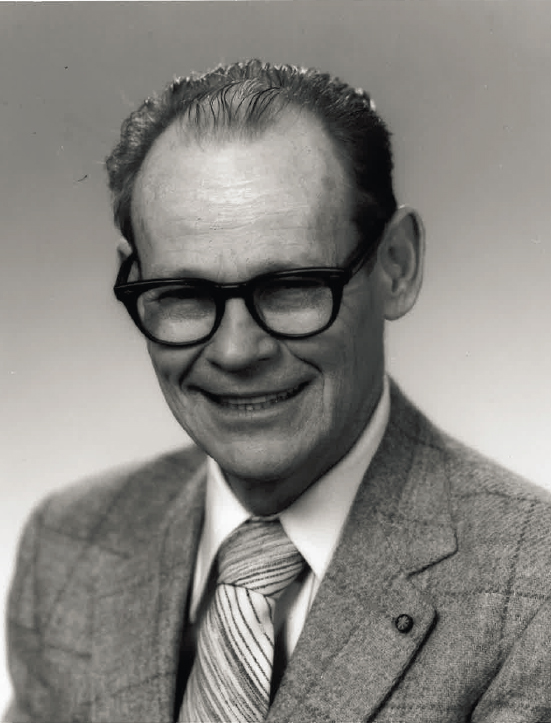
DERALD A. STUART
1925–2010
Elected in 1983
“Major engineering contributions and technical direction leading to the successful development and operation of the Fleet Ballistic Missile System.”
BY L. DAVID MONTAGUE
DERALD ARCHIE STUART had a long and distinguished career as vice president and general manager of Lockheed’s Missile Systems Division in Sunnyvale, California, and vice president of the parent Lockheed Corporation. He led the successful development, production, and fleet support of the US Navy’s Fleet Ballistic Missile Programs from 1970 until his retirement in 1987. Those programs in which he played a major role are widely acknowledged as among the most successful in Department of Defense history. He died May 26, 2010, at the age of 84.
He was born November 9, 1925, in Bingham Canyon, Utah, and served in the US Navy during World War II before attending the University of Utah, where he earned his BS, MS, and PhD in physics in 1947, 1948, and 1950. While in graduate school he met and married his lifelong beloved Isabel and they had two children. After graduation he was hired as an associate professor at Cornell University, where he taught engineering materials, mechanics, and mathematics. He conducted research in materials, dynamic behavior of structures, electric and plastic wave propagation, and theory of the glassy state.
While at Cornell Stuart consulted for several government agencies, coauthored Engineering Mechanics with Dwight Gunder (John Wiley & Sons, 1959), and coauthored numerous
articles and reports for various technical journals and the proceedings of the Joint Army-Navy-Air Force Solid Propellant Committee.
I first encountered Dr. Stuart in 1953 when I was an engineering student at Cornell; he was teaching a materials course on metallurgy. He would occasionally be away from campus and the rumor was that he was consulting on some “secret bomb project” for the government. After graduating and going to work for Lockheed in 1956, I found that the “secret project”—on which Dr. Stuart was consulting for the US Navy—was exploring the feasibility of developing much larger, more energetic, and longer-burning solid-rocket motors than any existing at the time.
That work helped to establish the basis for what was to become the US Navy Polaris submarine-launched ballistic missile program. It also led in 1958 to his joining Lockheed’s recently formed Missile Systems Division that had been chosen 2 years earlier to develop the Polaris.
At Lockheed, Stuart made major engineering and management contributions to the successful development and operation of six generations of the US Navy’s Fleet Ballistic Missile (FBM) programs, initially as manager of the missile systems propulsion staff, with responsibility for overseeing development of the solid-propellant rocket propulsion for the Polaris program. In 1966 he was named chief engineer of the Missile Systems Division. Four years later he was selected as VP and general manager of the division, with responsibility for all of Lockheed’s work on the longer-range Trident I and II FBM programs and more than 10,000 engineers, scientists, subcontractors, and manufacturing employees. He held that position for nearly 17 years until he retired in 1987.
Stuart served on the Army Scientific Advisory Board and National Contract Management Association Board of Advisors, and was a fellow of the American Institute of Aeronautics and Astronautics. His honors included election to the NAE in 1983, the AIAA Wyld Propulsion Award (1979) for “outstanding achievement in the development or application of rocket propulsion systems”; the John J. Montgomery Award (1964) from
the National Society of Aerospace Professionals; the US Navy Meritorious Public Service Award; and the Navy Certificate of Commendation, Navy Strategic Systems Program Director’s Steering Task Group (1968–77).
To me, as one who worked with Dr. Stuart for almost 30 years, it was clear that he was above all a man of uncompromising integrity and honesty. He embraced and practiced the ideals of partnership between customer and contractor, leader and subordinate, based on earned trust and open communication. In that regard he always sought win-win solutions at every level of relationships and was known for his “over-the-horizon radar” and taking the long view, earning the respect of his customers, suppliers, employees, and associates.
After his retirement, the Stuarts moved to Arizona where he pursued his hobbies of woodworking and painting, and continued to study philosophy, astronomy, and mathematics. He was survived by Isabel (she died October 25, 2018); their children, twins Ronald Sturtevant-Stuart and Ryda Stuart; and two grandchildren.




